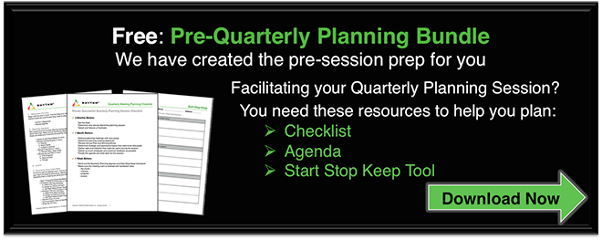Business is moving faster than ever before, and these days your business needs to be as nimble possible to respond to the rapidly changing business landscape. In today’s nonstop global economy, there is always somebody, somewhere trying to capture part of your market and your customers. This has only increase with the global coronavirus COVID-19 pandemic, you need to be able to pivot faster than ever with your strategic growth planning. You need to create an organization able to respond to the changes in the market more quickly than ever, or you will lose market share to the competition. Unfortunately, many of the legacy software tools that businesses use don’t adapt fast enough to work in today’s cutthroat global economy and need to be modernized. Software teams realized this decades ago and quickly shifted from the outmoded Waterfall methodology to the Agile software development framework; it is time for the traditional business planning to catch up to this advancement when implementing business strategy.
to respond to the rapidly changing business landscape. In today’s nonstop global economy, there is always somebody, somewhere trying to capture part of your market and your customers. This has only increase with the global coronavirus COVID-19 pandemic, you need to be able to pivot faster than ever with your strategic growth planning. You need to create an organization able to respond to the changes in the market more quickly than ever, or you will lose market share to the competition. Unfortunately, many of the legacy software tools that businesses use don’t adapt fast enough to work in today’s cutthroat global economy and need to be modernized. Software teams realized this decades ago and quickly shifted from the outmoded Waterfall methodology to the Agile software development framework; it is time for the traditional business planning to catch up to this advancement when implementing business strategy.
Many businesses have relied solely on the outdated static strategic annual plan for way too long. This type of plan outlines all of the strategic goals you wish to achieve during the year with little to no thought about the steps required actually to achieve the initiatives. What good are strategies if you don’t have a plan to execute them in your 3 year strategic plan example? Rhythm Systems recommends creating a handful of Key Initiatives you want to accomplish over the year and developing a quarterly planning rhythm to create four 13-week plans in successive quarters that iterate based on the current information available at the time of planning. A year plan is absolutely needed, especially in resource planning but you need to be able to have agile planning processes AND traditional planning for resource allocation.
One of the major challenges associated with solely having an annual strategic plan is that it doesn’t allow you to respond quickly enough to changes in the marketplace. Your business is stuck working on what seemed like a great idea months ago but may not affect the current business environment. Even if it is still a great concept, tweaks and adjustments will likely be required based on feedback gathered during the process. The second major flaw is that these plans often focus solely on strategy or WHAT you want to get done and not on the execution or HOW you are going to do it. A great plan needs to be holistic and clearly outline what you need to do in order to order to turn the strategy into reality and provide a straightforward executable roadmap to complete the goals.
Rhythm Systems' agile business planning methodology works with companies to create hundreds of clear quarterly execution plans every quarter based on each customer's Annual Key Initiatives. These execution plans have a clear set of objectives, success criteria, action items, responsibilities, and due dates for your strategy that can be accomplished (read: actually get done) during the next quarter. In meticulously defining what needs to get done and how to do it, we change customers' “wish lists” to actual plans that are reliable and predictable. Rhythm’s Quarterly Planning methodology takes the 3-5 Key Initiatives from your annual plan and segments them into what can be accomplished in each of the four quarters with our four-quarter flyover tool. We call these each of these four quarters thirteen-week races®.
Instead of focusing on the mountain, or your long-term plan, or year plan, we focus on what needs to be done this quarter to get us to the first base camp. After reaching the first base camp, we take what we have learned and apply that to get to the second base camp. After you reach each plateau, you evaluate what you could get done, re-analyze the market and your business and use real-world data to update your plan. These adjustments to the current market conditions can be large or small but are vital as you start the race toward the next objective. The Rhythm methodology allows you to take the annual plan and break it down into quarterly manageable pieces that are easier to execute and have more transparency and clarity.
If your company is currently only using annual planning as part of your planning cycle, it is really easy to start planning for the next quarter. Assemble the appropriate team members, typically, the best place to start is with the executive committee and have them decide the top three to five objectives that the company can achieve in the next quarter or 90 days. Then, clearly define your success criteria, and don’t forget this also includes what failure looks like; at Rhythm, we use the Red-Yellow-Green system to make tracking each of the thirteen weeks easy. Ensure that everyone knows what they are accountable for and their key milestones to ensure they are on track. Keep everyone updated at your weekly meetings and brainstorm to solve any obstacles that have come up.
9 Tips for Agile Business Planning for Growth:
- Have Annual and Quarterly Plans. Check out our free resources for Annual Plans and Quarterly Plans
- Focus on 3-5 Company Priorities for the company any more than that, and you will get distracted and lose the focus needed to achieve
- Concentrate on 3-5 Group Priorities at the departmental level - such as sales, customer service, or marketing
- Define 3-5 Individual Priorities for each person in your organization
- Break down large projects into smaller tasks that can be completed in the next 13-week race; remember the goal is to be able to have reliable plans so make them realistic
- Set clear success criteria with SMART Goals at the beginning of the quarter so that all parties have alignment on what success looks like
- Set milestones to know that your priorities are on track to be completed in the quarter
- Make adaptations as needed in your weekly adjustment meeting to stay on track, respond to the current market conditions, and out-execute the competition
- Use a cloud based system, such as Rhythm agile business planning software, to track progress and collaborate to solve the business challenges and opportunities that are sure to arise
Read how Rhythm Strategy Execution Software and Agile Scrum work together, and feel free to check out all of our free resources to help you with your business process improvements!
Want to learn more about Agile Business Quarterly Planning? Check out these additional quarterly planning resources:
Value of Outside Facilitation for Quarterly and Annual Planning
EOS Rock Examples: Using Priorities and Quarterly Rocks to Align Your Organization (Infographic)
The Anatomy of a Great Quarterly Plan (Infographic)
Lean Quarterly Planning: How Complex Companies Drive Out Waste
10 Tips for a Successful Quarterly Planning Session (Video)
How to Choose the Right Priorities During Your Quarterly Planning Session
Tips to Help You Prepare to Facilitate Your Next One-Day Quarterly Planning Session
How Much Time Should I Allocate for My Quarterly Planning Session?
The Definitive Guide to Quarterly Planning
Rhythm Systems Quarterly Planning Resource Center
Photo Credit: iStock by Getty Images
Photo Credit: iStock by Getty Images



 LinkedIn
LinkedIn
 Facebook
Facebook

